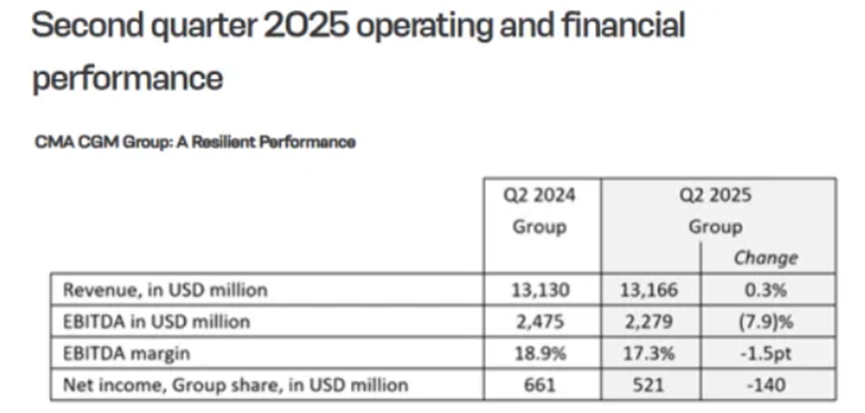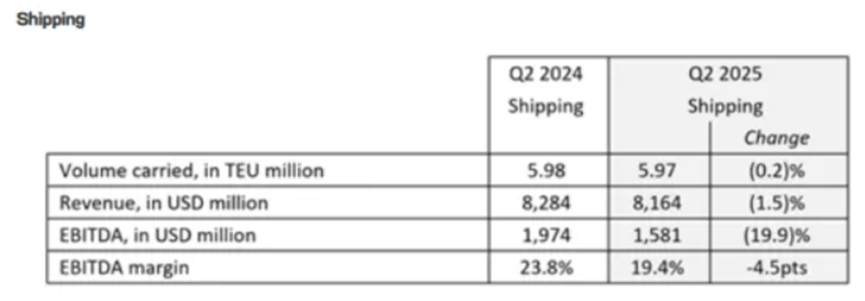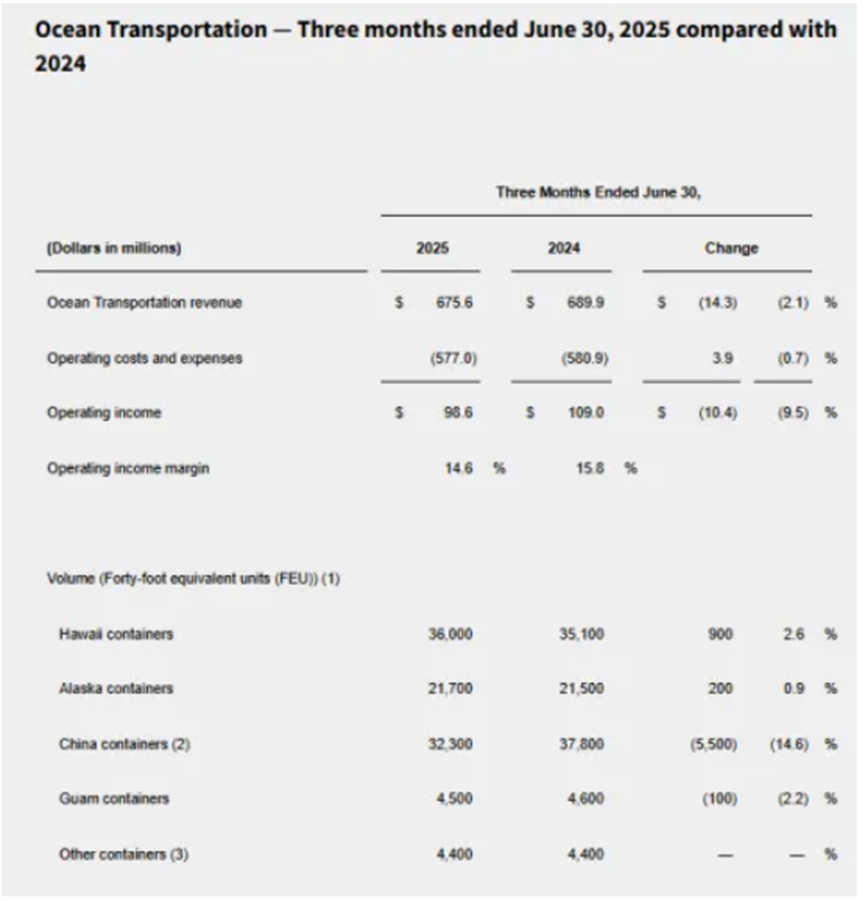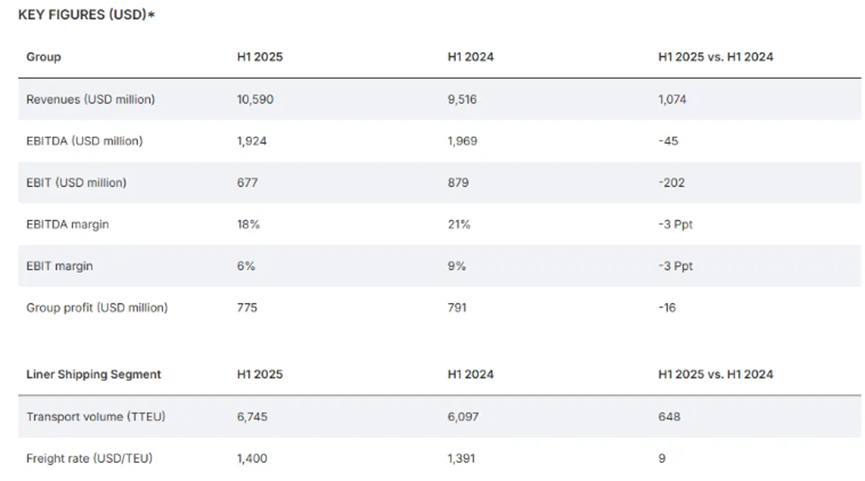Brief analysis of H1 2025 performance of major shipping and logistics companies
Major global container shipping companies and logistics enterprises have announced their financial reports for H1 2025 recently. Many witnessed reducing profit on the year and some adjusted down the forecast for the whole year.
OOCL
On July 11, OOCL (Orient Overseas Container Line) released its key performance data for the second quarter. In the second quarter, OOCL achieved a route revenue of $2.118 billion, a year-on-year decrease of 6.5%. During the same period, the cargo volume reached 1,962,850 TEUs (twenty-foot equivalent units), representing a year-on-year increase of 4.4%. Additionally, the average revenue per TEU decreased by 10.4% year-on-year.
Broken down by routes, in the second quarter, except for the Pacific route, where cargo volume declined by 4.3% year-on-year, OOCL saw growth in cargo volumes on the Asia-Europe route, Atlantic route, and intra-Asia/Australia-Asia route. The Atlantic route recorded the highest growth, with an increase of 20.5%, followed by the intra-Asia/Australia-Asia route at 7.9% and the Asia-Europe route at 3.1%.
In terms of route revenue, the Atlantic route also posted the largest growth at 25.4%, while the Pacific route decreased by 18.3%.
Furthermore, in the first half of this year, OOCL's route revenue increased by 4.4%, cargo volume grew by 6.8%, and the average revenue per TEU decreased by 2.2%.
Kuehne+Nagel
On July 24, Kuehne+Nagel, a global freight forwarding giant, released its first-half 2025 results. It achieved a net turnover of 12.48 billion Swiss francs (approximately 15.74 billion US dollars), representing an 8% year-on-year increase; its earnings before interest and taxes (EBIT) stood at 740 million Swiss francs (approximately 940 million US dollars), a 4% year-on-year decrease.

Specifically, in the second quarter of 2025, Kuehne+Nagel recorded a net turnover of 6.15 billion Swiss francs (approximately 7.76 billion US dollars), up 2% year-on-year; EBIT was 340 million Swiss francs (approximately 430 million US dollars), down 15% year-on-year.
Looking at the ocean freight business segment, in the first half of 2025, Kuehne+Nagel generated a net turnover of 4.71 billion Swiss francs (approximately 5.94 billion US dollars), a 16% year-on-year growth; EBIT for this segment was 370 million Swiss francs (approximately 460 million US dollars), down 7% year-on-year. Meanwhile, it handled 2.14 million TEUs of ocean freight, up 2% on annual basis.
In the second quarter of 2025 alone, the ocean freight business segment of Kuehne+Nagel achieved a net turnover of 2.21 billion Swiss francs (approximately 2.79 billion US dollars), a 4% year-on-year rise; EBIT was 160 million Swiss francs (approximately 200 million US dollars), a 21% year-on-year decrease. The ocean freight volume completed during this period reached 1.106 million TEUs, a 0.8% year-on-year growth.

Due to the uncertainty caused by exchange rate fluctuations, Kuehne+Nagel has lowered its 2025 performance forecast, expecting full-year EBIT to be between 1.45 billion and 1.60 billion Swiss francs (approximately 1.83 billion to 2.02 billion US dollars). In its first-quarter earnings report, Kuehne+Nagel had previously projected full-year EBIT to range from 1.50 billion to 1.75 billion Swiss francs (approximately 1.89 billion to 2.21 billion US dollars).
CMA CGM Group
On July 29, CMA CGM Group released its second-quarter 2025 results, achieving revenue of approximately 1.32 billion US dollars, which was roughly flat compared to the same period of last year; its earnings before interest, taxes, depreciation and amortization (EBITDA) stood at about 2.3 billion US dollars, a year-on-year decrease of 7.9%; and net profit was approximately 520 million US dollars, a year-on-year reduction of 21.2%.

Among them, the revenue of the ocean shipping segment was about 8.2 billion US dollars, a year-on-year decline of 1.5%; EBITDA for this segment was approximately 1.6 billion US dollars, down 19.9% on the year.
In addition, CMA CGM's average freight rate was 1,367 US dollars per TEU, a year-on-year drop of 1.2%; the freight volume completed was 5.97 million TEUs, which was roughly flat with the same period of last year.

DSV
On July 31, DSV, a freight forwarding giant, released its second-quarter and first-half 2025 results, marking its first earnings report since completing the acquisition of DB Schenker. It is understood that DB Schenker has been included in DSV's consolidated financial statements starting from May 1.

In the first half of 2025, DSV achieved revenue of 103.663 billion Danish kroner (approximately 15.892 billion US dollars), compared to 79.497 billion Danish kroner (approximately 12.187 billion US dollars) in the same period of last year; its earnings before interest, taxes and special items (EBIT) stood at 8.585 billion Danish kroner (approximately 1.316 billion US dollars), versus 7.740 billion Danish kroner (approximately 1.187 billion US dollars) in the corresponding period of the previous year.
Specifically, in the second quarter of 2025, DSV recorded revenue of 61.983 billion Danish kroner (approximately 9.501 billion US dollars), compared to 41.157 billion Danish kroner (approximately 6.309 billion US dollars) in the same quarter of last year; EBIT was 4.725 billion Danish kroner (approximately 724 million US dollars), versus 4.099 billion Danish kroner (approximately 628 million US dollars) in the year-ago quarter.
As for the ocean freight business segment, in the first half of 2025, DSV generated revenue of 28.406 billion Danish kroner (approximately 4.355 billion US dollars), compared to 21.8 billion Danish kroner (approximately 3.342 billion US dollars) in the same period of last year; gross profit for this segment reached 7.5 billion Danish kroner (approximately 1.150 billion US dollars), versus 5.987 billion Danish kroner (approximately 918 million US dollars) in the corresponding period of the previous year. During the same period, DSV handled 1.6029 million TEUs of ocean freight, representing a 23% year-on-year increase.
Given the current global trade situation and macroeconomic outlook, with high uncertainty remaining in the market, DSV maintained its forecast for full-year 2025 EBIT, which still ranges from 19.5 billion to 21.5 billion Danish kroner (approximately 2.989 billion to 3.296 billion US dollars).
After announcing the completion of the acquisition of DB Schenker, DSV stated that the acquisition would double its size. Following the consolidation of results, DSV's annual revenue is expected to reach approximately 310 billion Danish kroner (approximately 47.523 billion US dollars).
ONE
Ocean Network Express (ONE) recently released its financial results for the first quarter of the 2025 fiscal year (April - June 2025).
During the reporting period, ONE achieved revenue of 4.049 billion US dollars, a 4% year-on-year decrease; net profit stood at 86 million US dollars, a significant 89% year-on-year decline.

Looking ahead to the 2025 fiscal year, ONE stated cautiously that due to the situation in the Red Sea region and the increased uncertainty in the recent trade market, it has become more difficult to forecast profits for the 2025 fiscal year.
In light of this, ONE has lowered its full-year profit forecast, expecting 2025 revenue to be 17.1 billion US dollars with a net profit of 700 million US dollars. Previously, ONE had projected 2025 revenue to reach 17.5 billion US dollars and net profit to be 1.1 billion US dollars.
Matson
Recently, Matson, Inc. released its second-quarter 2025 financial results. During the reporting period, the company achieved consolidated revenue of approximately $830 million, a year-on-year decrease of 2.0%; net profit stood at $94.7 million, a year-on-year decline of 16.3%.

In addition, during the reporting period, Matson's ocean shipping business revenue reached $676 million, down 2.1% year-on-year; operating profit for this segment was $98.6 million, a 9.5% year-on-year decrease. Furthermore, in the second quarter, the company's cargo volume in the Chinese market was 32,300 FEU, a year-on-year drop of 14.6%.

Regarding the performance outlook for the third quarter, Matson expects the operating profit of its ocean shipping business to be significantly lower than the level in the same period of 2024, mainly due to year-on-year declines in both freight rates and cargo volumes on the China-US routes. In addition, Matson anticipates that the peak season this year will be relatively "subdued."
DPDHL
On August 5, DPDHL Group, which owns the DHL brand-ranked the world's third-largest ocean freight forwarder and second-largest air freight forwarder-released its second-quarter 2025 results.

In the second quarter, DPDHL Group achieved revenue of 19.826 billion euros (approximately 22.952 billion US dollars), a year-on-year decrease of 3.9%; its earnings before interest and taxes (EBIT) stood at 1.429 billion euros (approximately 1.654 billion US dollars), a year-on-year increase of 5.7%.
In addition, in the first half of the year, DPDHL Group generated revenue of 40.634 billion euros (approximately 47.041 billion US dollars), a year-on-year decline of 0.6%; EBIT reached 2.799 billion euros (approximately 3.240 billion US dollars), a year-on-year growth of 5.1%.

Breaking down by business segment, in the second quarter, revenue from the Global Forwarding, Freight business (DHL Global Forwarding, Freight) was 4.620 billion euros (approximately 5.348 billion US dollars), a year-on-year decrease of 5.3%; EBIT for this segment was 196 million euros (approximately 227 million US dollars), a year-on-year drop of 29.7%.
Commenting on the performance, Melanie Kreis, Chief Financial Officer of DPDHL Group, stated: "In the second quarter, escalating trade conflicts and geopolitical tensions impacted the global economy. Against this backdrop, our diversified business portfolio provided stable support for the company's overall development. We anticipate that global economic volatility will persist in the second half of the year. Based on this judgment, we will actively seize growth opportunities, continue to deepen efficiency improvements, and focus on deploying in high-growth markets."
DPDHL Group noted that its ongoing "Fit for Growth" cost-control initiative is expected to enhance profitability. Based on this, the company maintains its 2025 performance forecast of an EBIT of at least approximately 6 billion euros (approximately 6.946 billion US dollars).
Maersk
A.P. Møller-Maersk Group (Maersk) has just released its strong performance for the second quarter of 2025, with revenue increasing by 2.8% year-on-year and earnings before interest and taxes (EBIT) reaching $845 million. Although there was a sequential decline, the overall performance remained flat compared to the same period last year, reflecting Maersk's stable performance amid heightened geopolitical uncertainties and continued pressure on freight rates.
The guidance for the second half of the year has been upgraded, mainly driven by the following factors: the continued strength of the terminal business, rising cargo volumes in the shipping segment, enhanced profitability of the logistics and services business, as well as the continuous optimization of operations and strict cost control across all business segments. In view of the stronger resilience of market demand outside North America, Maersk has decided to upgrade its full-year 2025 financial guidance.
Evergreen Marine, Yangming Marine, and Wanhai Lines
Taiwan China's three major shipping companies, Evergreen Marine, Yangming Marine, and Wanhai Lines, have successively released their first-half 2025 financial results in recent days.
During the reporting period, Evergreen Shipping achieved operating revenue of approximately NT$196.45 billion (equivalent to about US$6.564 billion), a year-on-year increase of 0.8%; the net profit attributable to parent company shareholders was approximately NT$38.32 billion (equivalent to about US$1.280 billion), a year-on-year decrease of 18.2%.
Yangming Marine recorded operating revenue of about NT$84.17 billion (equivalent to approximately US$2.808 billion) in the first half of the year, a year-on-year decrease of 12.7%; the net profit attributable to parent company shareholders was approximately NT$8.76 billion (equivalent to about US$292 million), down 62.4% on the year.
Wanhai Lines' consolidated operating revenue in the first half of the year was NT$71.94 billion (equivalent to about US$2.4 billion), a year-on-year increase of 9.4%; the net profit attributable to parent company shareholders was NT$9.81 billion (equivalent to about US$328 million), down 39.4% on annual basis.
Hapag-Lloyd
On August 14, Hapag-Lloyd released its first-half results for 2025. During the reporting period, Hapag-Lloyd achieved operating revenue of US$10.59 billion, a year-on-year increase of 11.3%; its earnings before interest, taxes, depreciation, and amortization (EBITDA) stood at US$1.92 billion, a year-on-year decrease of 2.3%; and its earnings before interest and taxes (EBIT) was US$680 million, down 23% year on year.
In the reporting period, Hapag-Lloyd's cargo volume reached 6.745 million TEUs, a year-on-year increase of 10.6%; the average freight rate was US$1,400 per container, a year-on-year increase of 0.6%.

Based on the first-half performance, Hapag-Lloyd has adjusted its 2025 fiscal year earnings forecast, expecting EBITDA to be between US$2.8 billion and US$3.8 billion, and EBIT to range from US$250 million to US$1.25 billion. Previously, Hapag-Lloyd had projected full-year EBITDA to be between US$2.5 billion and US$4 billion, with EBIT ranging from US$0 to US$1.5 billion.
The company also emphasized that due to multiple uncertainties such as geopolitical risks and freight rate fluctuations, there are still significant variables in this forecast.
- Top keywords
- Cotton Price
- Cotton Futures Price
- Cotton Futures
- CZCE
- PTA Futures Price
- Chemical Fiber
- Polyester Prices
- Wool price
- PTA Futures
- Shengze Silk
- China
- Yarn Price
- price
- China Textile City
- Fibre Price
- Benzene Price
- Cotton
- Index
- Cotton Index
- PTA
- fabric price
- NYMEX
- Top 10
- textile industry
- Spot Cotton
- Cotton Yarn
- Polyester Price
- Futures
- PTA Price
- cotton yarn price

